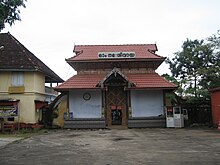
The Srikalahasti Temple is located in the town of Srikalahasti, in Tirupati district in the state of Andhra Pradesh, India. According to regional tradition, it is said to be the site where Kannappa was ready to offer both his eyes to cover blood flowing from the Shivalinga before Shiva stopped him and granted him moksha. The inner temple was constructed around the 5th century CE and the outer temple was constructed in the 11th century by the Rajendra Chola I and other Chola emperors such as Rajaditya Chola, Rajaraja Chola I, Rajadhiraja Chola I, Kulottunga Chola I, Kulottunga Chola III. And Vijayanagar Empire. The 120 feet (37 m) high main gopuram and the hundred pillared hall with intricate carvings was commissioned during the regime of the Vijayanagara Krishnadevaraya during 1516 CE. Shiva in his aspect as Vayu is worshipped as Kalahasteeswara. The temple is also regarded as Rahu-Ketu kshetra and Dakshina Kailasam.

The Vadakkumnathan Temple is an ancient Hindu temple dedicated to Shiva in Thrissur, in the Thrissur district of Kerala, India. The temple is a classical example of the architectural style of Kerala and has one monumental tower on each of the four sides in addition to a koothambalam. Mural paintings depicting various scenes from the Mahabharata can be seen inside the temple. The shrines and the Kuttambalam display vignettes carved in wood. The temple, along with the mural paintings, has been declared as a National Monument by India under the AMASR Act. According to popular local lore, this is the first temple built by Parashurama, the sixth avatar of Vishnu. Thekkinkadu Maidan, encircling the Vadakkumnathan Temple, is the main venue of the renowned Thrissur Pooram festival.
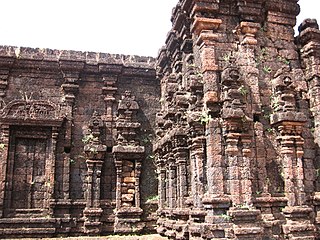
The Rajarajeshwara temple is a Shiva temple located in Taliparamba in Kannur district of Kerala State of India. The temple is regarded as one of the existing 108 ancient Shiva Temples of ancient Kerala. It also has a prominent place amongst the numerous Shiva temples in South India. It had the tallest shikhara amongst the temples of its time. The Rajarajeshwara temple has a top of about 90 tonnes. If any problem is encountered in the other temples of South India, devotees seek a solution in this temple through a prashnam, a traditional method of astrological decision-making. The prashnam is conducted on a peedha outside the temple.
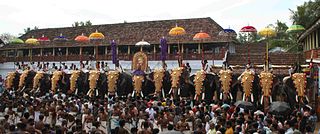
Sree Poornathrayesa temple is a Hindu temple situated in Tripunithura, Kochi, the capital of the former Kingdom of Cochin, Kerala, India. The temple is considered among the greatest temples in Kerala and was the first among eight royal temples of the erstwhile Kingdom of Cochin. The presiding deity is Vishnu as Santhanagopala Murthy or Poornathrayeesa. He was the national deity of Cochin and protector guardian of Tripunithura. Poornathrayeesa is known for his love of elephants. Hence more than 40 elephants participate in his Vrishchikotsavam.

The Aranmula Parthasarathy Temple is a Hindu temple located near Aranmula, a village in Pathanamthitta District, Kerala, South India. It is dedicated to the Lord Krishna, an avatar of Vishnu, who is worshipped as Parthasarathy. Constructed in the Kerala style of architecture, it is one of the "Divya Desams", the 108 temples of Vishnu revered by the Alvar saints.
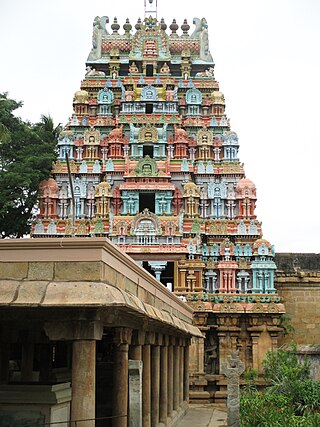
Jambukeswarar Temple, Thiruvanaikaval is a temple of Shiva in Tiruchirapalli district, in the state of Tamil Nadu, India. It is one of the five major Shiva Temples of Tamil Nadu representing the Mahābhūta or five elements; this temple represents the element of water, or neer in Tamil. The sanctum of Jambukeswara has an underground stream.

The Vilwadrinatha Temple is a Hindu temple in Thiruvilwamala, a town in the city of Thrissur, Kerala, India. The principal deities are Rama, the seventh incarnation of the god Vishnu, and his brother, Lakshmana. It figures among the Abhimana Kshetrams in Vaishnavite traditions. This is one of the four major Rama temples in Kerala — the other three are in Thriprayar, Kadavallur, and Thiruvangad. The temple houses an idol of Lakshmana, which is rare in India. Vilwadrinatha Temple is located in the centre of the community of Thiruvilwamala, atop a 100-foot-high hillock. Visible from the temple is Bharathappuzha, the second-largest river in Kerala, which flows past the temple's northern side from around 3 kilometres away.

Anandavalleeswaram Sri Mahadevar Temple in Kollam city is one of the ancient Hindu temples in Kerala, India. Lord Siva and Goddess Anandavally are the main deities of the temple. According to folklore, sage Parashurama has installed the idol of Lord Shiva. The temple is a part of the 108 famous Shiva temples in Kerala. It is located at Anandavalleeswaram, a major neighborhood of Kollam city, that comes to the west side of Kollam Collectorate.
Annamanada is a village in a southern corner of Thrissur district in the Indian state of Kerala. It is situated 8 km from Mala and 10 km south of Chalakudy.The locals call Annamanada as "Annanta" and"Annamanta"

The Vaikom Sree Mahadeva Temple is a temple dedicated to the Hindu god Shiva in Vaikom, Kottayam, Kerala, India.

The Sreevallabha Temple is an orthodox Hindu temple dedicated to Sreevallabha, a form of Vishnu. It is located in the city of Thiruvalla, India.
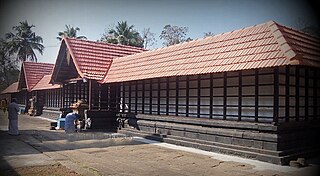
Thumpamon Vadakkumnatha Temple is an ancient temple near Pandalam in Pathanamthitta in Kerala, India. This temple has two Sreekovils. Both Sreekovils are round (vatta). It is an age old temple whispering several fascinating legends of the bygone eras.

The Mullakkal Rajarajeswari Temple is a Hindu temple in Mullakkal, Alappuzha, Kerala, India. The temple is also known as the Mullakkal Bhagwati Temple. The temple was designed and built in the old Kerala style. The temple grounds is filled with jasmine plants, after which the place may have been named, since 'mullai' in Tamil and 'mulla' in Malayalam mean jasmine. There are several stories related to the origin of the temple and its foundation. The idol in the inner shrine is that of the goddess Durga. The temple is run by the Travancore Devaswom Board.

Ettumanoor Mahadeva temple is an ancient Shiva temple in Kottayam, Kerala, India. The temple is one of the major Shiva temples in Kerala, along with Vaikom Temple, Kaduthruthy Mahadeva Temple, Chengannur Mahadeva Temple, Vazhappally Maha Siva Temple, Ernakulam Shiva Temple, Vadakkunathan temple and Sreekanteswaram Mahadeva Temple, Thiruvananthapuram.

Vazhappally Maha Siva Temple is a Hindu temple located in Vazhappally near Changanassery in Kottayam district in the Indian state of Kerala. The temple is administered by the Travancore Devaswom Board. The temple is believed to be constructed by the first Chera king of Kodungallur. The legends suggest that the installation of the idol of god Mahadeva (Shiva) was performed by Parasurama himself. This temple is one among the 108 Shiva temples established by Parasurama. It is one of the few temples in Kerala where two nalambalams and two flag-masts are dedicated. The temple, a Grama Kshetra, also contains some seventeenth century wood carvings depicting figurines from epics. A Vattezhuttu inscription on the northern part of the base of the cultural shrine indicates that the repairs were completed in Kollam Era 840 (1665 CE).
Chittoor Sree Krishnaswamy Temple, located at South Chittoor in the city of Kochi, Kerala, India, is a temple dedicated to Lord Krishna. It is a major temple under the Cochin Devaswom Board. For centuries the temple was closely associated with the Kartha family of Cheranelloor Swaroopam and was later taken over by Rama Varma Maharaja of Cochin Royal Family. It is a classic example of Kerala temple architecture.
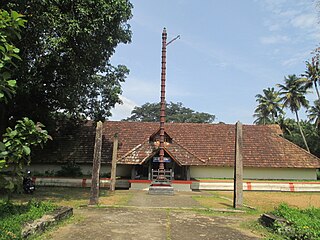
The Thrichittatt Mahavishnu Temple is a Hindu temple dedicated to Vishnu, located in Chengannur, Alappuzha District, Kerala, South India. Constructed in the Kerala style of architecture, the temple is glorified in the Nalayira Divya Prabandham, by Nammalvar, one of the Sri Vaishnava saint-poets of the 8th century called the Alvars. It is one of the 108 Divya Desams dedicated to Krishna, an avatar of Vishnu, who is worshipped as Imayavarappan. The nearest railway station to the temple is located in Chengannur, while the nearest airports are Trivandrum International Airport and Cochin International Airport Ernakulam.
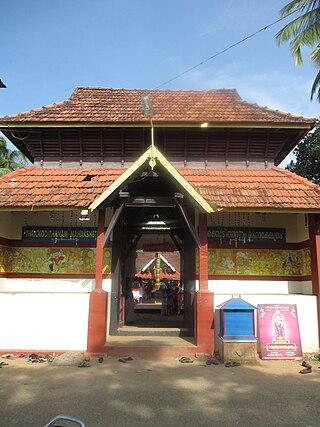
Thrikodithanam Mahavishnu Temple is a Hindu temple dedicated to Vishnu and located in Thrikkodithanam, Kottayam District, Kerala, South India. Constructed in the Kerala style of architecture, the temple is glorified in the Nalayira Divya Prabandham, the early medieval Tamil canon of the Alvar saints from the 6th–9th centuries CE. It is one of the 108 Divya Desam dedicated to Krishna, an avatar of Vishnu, who is worshipped as Mahavishnu. The nearest railway station to the temple is located in Changanassery, while the nearest airport is Cochin International Airport.

Tali Shiva Temple or Tali Mahakshetram is a Hindu temple dedicated to the deity Shiva, situated in the heart of the Kozhikode city, Kerala. The temple was built in the 14th century by Zamorin of Calicut. Tali Kshetram is an ancient temple in the heart of Kozhikode town. Shiva is the presiding deity. The Jyothirlingam in the Sanctum Sanctorum is believed to have been installed by Parasuraman. The temple is one km to the east of Kozhikode railway station. It is surrounded by the Palayam market. This was the family temple of the Zamorins who had ruled Kozhikode. Although the temple is now under Malabar Devaswom, the Zamorin is the managing trustee. The temple is built in traditional Kerala architectural style. The two-storied sanctum-sanctorum is in the shape of a chariot. It is adorned with murals and granite sculptures of Shiva’s retinue. Inside Sree Kovil deities of Tali Ganapathy, Thevarathil Ganapathy and Thrumandhakunnu Bhagavathy are installed. Sree Krishna, Thevarathil Bhagavathy, Ayyappa, Sri Vishnu and Nagam are installed outside Shiva Temple. Sree Valayanad Bhagavati idol is installed inside Sree Krishna Temple. There is a small Narasimha Moorthy temple on the southern side of the Sri Vishnu Temple.
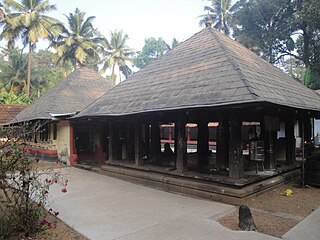
Thiruvatta Mahadeva Temple is an ancient Hindu temple dedicated to Lord Shiva is situated on the banks of the Manimalayar (river) in Thiruvalla of Pathanamthitta District in Kerala state in India. Reference to this temple is found in Vazhappally inscription relates to the rule of Kodungallur Chera king Rama Rajasekhara and temple at Vazhappally. It is the earliest available epigraphical record mentioning a Kodungallur Chera king and written in Malayalam language. According to folklore, sage Parashurama has installed the idol of Lord Shiva in the Treta Yuga. The temple is a part of the 108 famous Shiva temples in Kerala.
